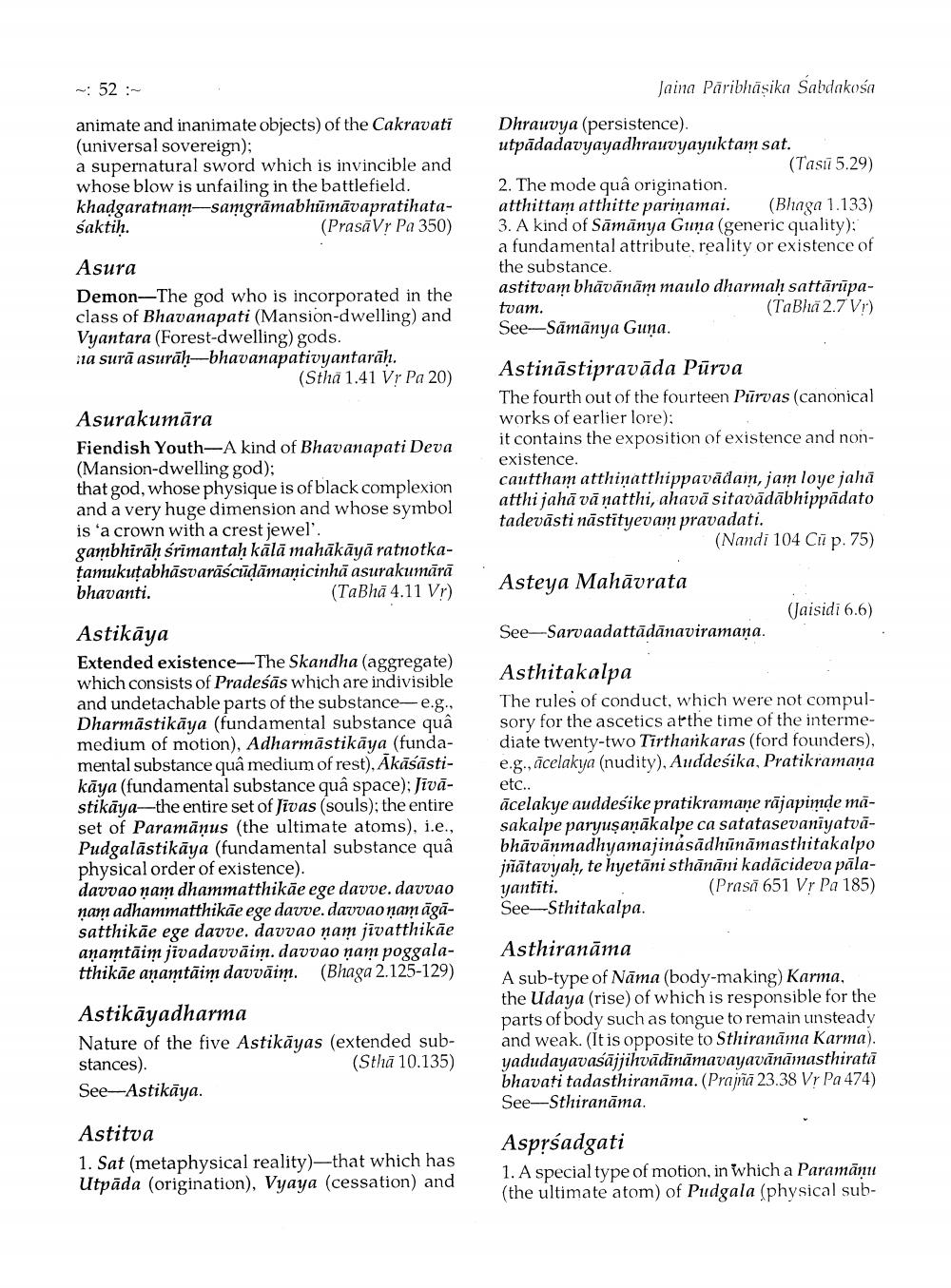________________
- 52:
Jaina Pāribhásika Sabdakośa
animate and inanimate objects) of the Cakravati (universal sovereign); a supernatural sword which is invincible and whose blow is unfailing in the battlefield. khadgaratnam-samgrāmabhūmāvapratihatasaktih.
(Prasā Vr Pa 350)
Dhrauvya (persistence). utpādadavyayadhrauvyayuktam sat.
(Tasii 5.29) 2. The mode quâ origination. atthittamatthitte parinamai. (Bhaga 1.133) 3. A kind of Sāmānya Guna (generic quality); a fundamental attribute, reality or existence of the substance. astitvam bhāvānām maulo dharmah sattārūpatuam.
(Tabha 2.7 V!) See-Sāmānya Guna.
Asura Demon-The god who is incorporated in the class of Bhavanapati (Mansion-dwelling) and Vyantara (Forest-dwelling) gods. ila surā asurāḥ-bhavanapativyantarāḥ.
(Sthā 1.41 Vr Pa 20)
Asurakumāra Fiendish Youth-A kind of Bhavanapati Deva (Mansion-dwelling god); that god, whose physique is of black complexion and a very huge dimension and whose symbol is 'a crown with a crest jewel'. gambhirāḥ srimantaḥ kālā mahākāyā ratnotkatamukutabhāsvarāścūdāmaņicinhā asurakumārā bhavanti.
(Tabhā 4.11 Vr)
Astināstipravāda Pürva The fourth out of the fourteen Pūrvas (canonical works of earlier lore); it contains the exposition of existence and nonexistence. cauttham atthiņatthippavādam, jam loye jahä atthi jahā vā natthi, ahavä sitavādābhippădato tadevāsti nāstityevam pravadati.
(Nandi 104 Cū p. 75)
Asteya Mahāvrata
(Jaisidi 6.6)
See-Sarvaadattādānaviramana.
Astikāya Extended existence-The Skandha (aggregate) which consists of Pradeśās which are indivisible and undetachable parts of the substance-e.g., Dharmāstikāya (fundamental substance quâ medium of motion), Adharmāstikāya (fundamental substance quâ medium of rest), Ākāśāstikāya (fundamental substance quâ space); Jivastikāya--the entire set of Jivas (souls); the entire set of Paramānus (the ultimate atoms), i.e., Pudgalāstikāya (fundamental substance quâ physical order of existence). davvao nam dhammatthikāe ege davve. davvao nam adhammatthikāe ege davve. davvao nam āgāsatthikāe ege davve. davvao nam jivatthikäe anamtāim jivadavvāim. davvao nam poggalatthikāe anamtāim davväim. (Bhaga 2.125-129)
Asthitakalpa The rules of conduct, which were not compulsory for the ascetics at the time of the intermediate twenty-two Tirtharkaras (ford founders), e.g., acelakya (nudity), Auddesika, Pratikramana etc.. ācelakye auddesike pratikramane rājapimde masakalpe paryusaņākalpe ca satatasevaniyatvābhāvänmadhyamajinasādhūnāmasthitakalpo jñātavyah, te hyetāni sthānāni kadācideva pālayantiti.
(Prasā 651 Vr Pa 185) See-Sthitakalpa.
Astikāyadharma Nature of the five Astikāyas (extended substances)
(Sthā 10.135) See-Astikāya.
Asthiranāma A sub-type of Nāma (body-making) Karma, the Udaya (rise) of which is responsible for the parts of body such as tongue to remain unsteady and weak. (It is opposite to Sthiranāma Karma). yadudayavasājjihvādīnāmavayavānāmasthiratā bhavati tadasthiranāma. (Prajna 23.38 Vr Pa 474) See-Sthiranāma.
Astitva 1. Sat (metaphysical reality)—that which has Utpāda (origination), Vyaya (cessation) and
Asprśadgati 1. A special type of motion, in which a Paramānu (the ultimate atom) of Pudgala (physical sub




